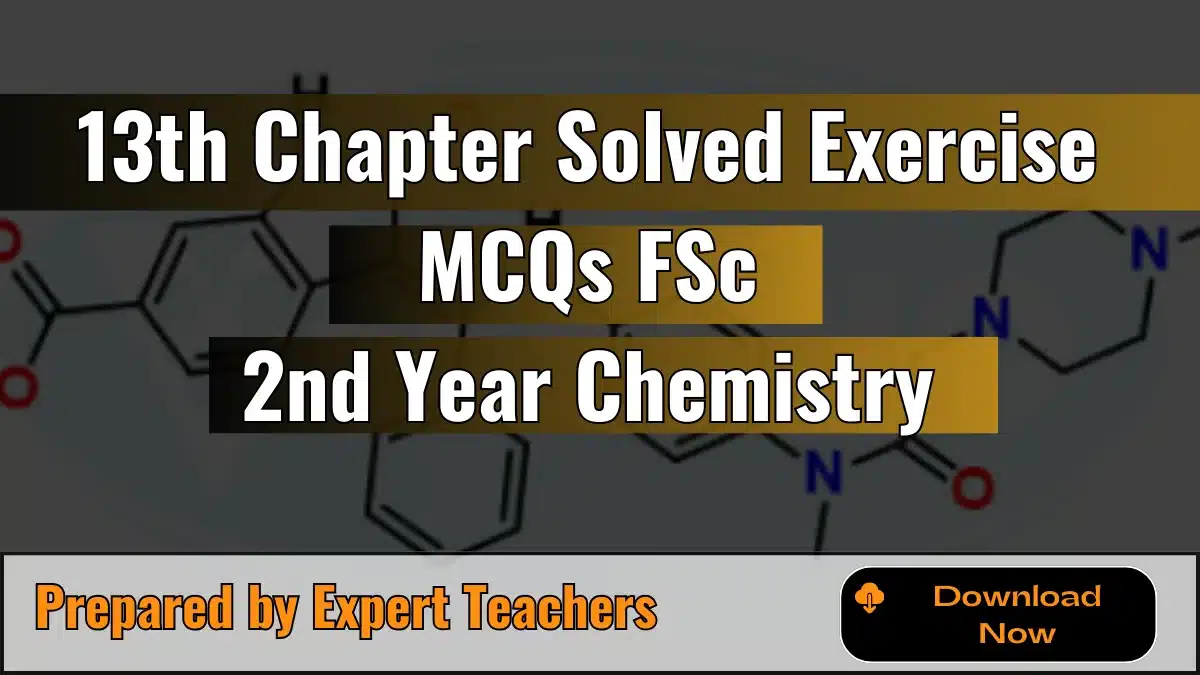10th Chapter Solved Exercise MCQs of FSC Second Year Chemistry
The 10th Chapter Solved Exercise MCQs of FSC 2nd-year Chemistry provides a complete set of solved multiple-choice questions (MCQs). Each MCQ comes with a brief explanation to help you understand the correct answer. These solutions are designed to support students in preparing for their exams, making complex concepts easier to grasp and ensuring a solid foundation for success.
10th chapter solved MCQs with explanation
1. In primary alkyl halides, the halogen atom is attached to a carbon which is further attached to how many carbon atoms?
(a) Two
(b) Three
(c) One
(d) Four
Explanation: Option (c) is correct. Because In primary alkyl halides, the halogen atom is attached to a carbon atom that is further connected to only one other carbon atom. This means the carbon with the halogen is a primary carbon, and it’s attached to just one additional carbon, making it a primary alkyl halide.
2. The reactivity order of alkyl halides for a particular alkyl group is:
(a) Fluoride > Chloride > Bromide > Iodide
(b) Chloride > Bromide > Fluoride > Iodide
(c) Iodide > Bromide > Chloride > Fluoride
(d) Bromide > Iodide > Chloride > Fluoride
Explanation: Option (c) is correct. Because The reactivity order of alkyl halides in nucleophilic substitution reactions is influenced by the bond strength between the carbon and the halogen. In alkyl halides, the bond strength decreases from fluorine to iodine.
- Iodide (I) has the weakest C-I bond and the largest atomic size, making it the most reactive.
- Bromide (Br) has a weaker C-Br bond than C-Cl, so it’s more reactive than chloride but less than iodide.
- Chloride (Cl) has a stronger C-Cl bond than C-Br, making it less reactive.
- Fluoride (F) has the strongest C-F bond, making it the least reactive.
3. When CO₂ is made to react with ethyl magnesium iodide, followed by acid hydrolysis, the product formed is:
(a) Propane
(b) Propanoic acid
(c) Propanal
(d) Propanol
Explanation: Option (b) is correct. Because When CO₂ reacts with ethyl magnesium iodide (which is a Grignard reagent), the reaction forms a carboxylate intermediate. After acid hydrolysis, this intermediate is converted into a carboxylic acid. Specifically, ethyl magnesium iodide reacts with CO₂ to form ethyl carboxylate, and upon acid hydrolysis, it yields propanoic acid.
4. Grignard reagent is reactive due to:
(a) The presence of a halogen atom
(b) The presence of Mg atom
(c) The polarity of C-Mg bond
(d) None of the above
Explanation: Option (c) is correct. Because The Grignard reagent, written as R-MgX (where R is an organic group and X is a halogen), is very reactive because of the carbon-magnesium (C-Mg) bond. In this bond, carbon is more electronegative than magnesium, giving carbon a partial negative charge (δ-) and magnesium a partial positive charge (δ+). This makes carbon nucleophilic, meaning it easily reacts with electrophiles, which is why Grignard reagents are widely used in organic synthesis to create new carbon-carbon bonds.
5. Sₙ2 reactions can be best carried out with:
(a) Primary alkyl halides
(b) Secondary alkyl halides
(c) Tertiary alkyl halides
(d) All the three
Explanation: Option (a) is correct. Because Sₙ2 reactions happen when a nucleophile attacks the carbon atom from the opposite side, leading to a direct swap of groups. Primary alkyl halides are best for Sₙ2 because they have less crowding around the carbon, making it easier for the nucleophile to attack. Secondary and tertiary alkyl halides have more groups around the carbon, which blocks the nucleophile, making Sₙ2 less likely.
6. Elimination bimolecular reactions involve:
(a) First-order kinetics
(b) Second-order kinetics
(c) Third-order kinetics
(d) Zero-order kinetics
Explanation: Option (b) is correct. Because In an E2 reaction, the rate depends on the concentration of both the substrate and the base, making it second order overall. The rate equation is:
Rate = k [substrate] [base]
This distinguishes it from E1 reactions, which follow first-order kinetics.
7. For which mechanisms, the first step involved is the same:
(a) E1 and E2
(b) E2 and Sₙ2
(c) Sₙ1 and E2
(d) E1 and Sₙ1
Explanation: Option (d) is correct. Because Both the E1 (Elimination Unimolecular) and Sₙ1 (Substitution Nucleophilic Unimolecular) mechanisms start with the same first step:
- The formation of a carbocation: In this step, the leaving group departs from the substrate molecule, resulting in the formation of a carbocation intermediate. After this step, the pathways diverge—E1 proceeds with the elimination of a proton to form an alkene, while Sₙ1 involves the nucleophile attacking the carbocation to form the substitution product.
8. Alkyl halides are considered to be very reactive compounds towards nucleophiles, because:
(a) They have an electrophilic carbon
(b) They have an electrophilic carbon and a good leaving group
(c) They have an electrophilic carbon and a bad leaving group
(d) They have a nucleophilic carbon and a good leaving group
Explanation: Option (b) is correct. Because Alkyl halides are reactive because the carbon atom bonded to the halogen is electrophilic, making it susceptible to nucleophilic attack. The halogen acts as a good leaving group, easily dissociating after the nucleophile attacks, facilitating the reaction.
9. The rate of E1 reaction depends upon:
(a) The concentration of substrate
(b) The concentration of nucleophile
(c) The concentration of substrate as well as nucleophile
(d) None of the above
Explanation: Option (a) is correct. Because In an E1 (Elimination Unimolecular) reaction, the rate-determining step involves the formation of a carbocation intermediate from the substrate, and this step is unimolecular. This means the rate of the reaction depends only on the concentration of the substrate. The nucleophile does not affect the rate of the E1 reaction because it attacks the carbocation in a subsequent, separate step.
10. Which one of the following is not a nucleophile:
(a) H₂O
(b) H₂S
(c) BF₃
(d) NH₃
Explanation: Option (c) is correct. Because A nucleophile is an electron pair donor. H₂O ,H₂S , NH₃ and all have lone pairs of electrons and can donate them, making them nucleophiles. BF₃, however, lacks lone pairs and is electron-deficient, acting as an electrophile instead.







Leave a Reply